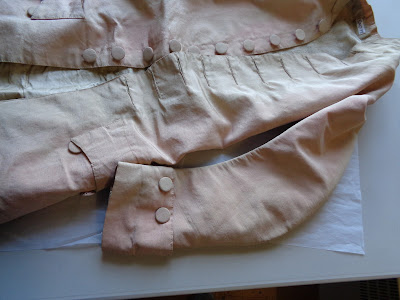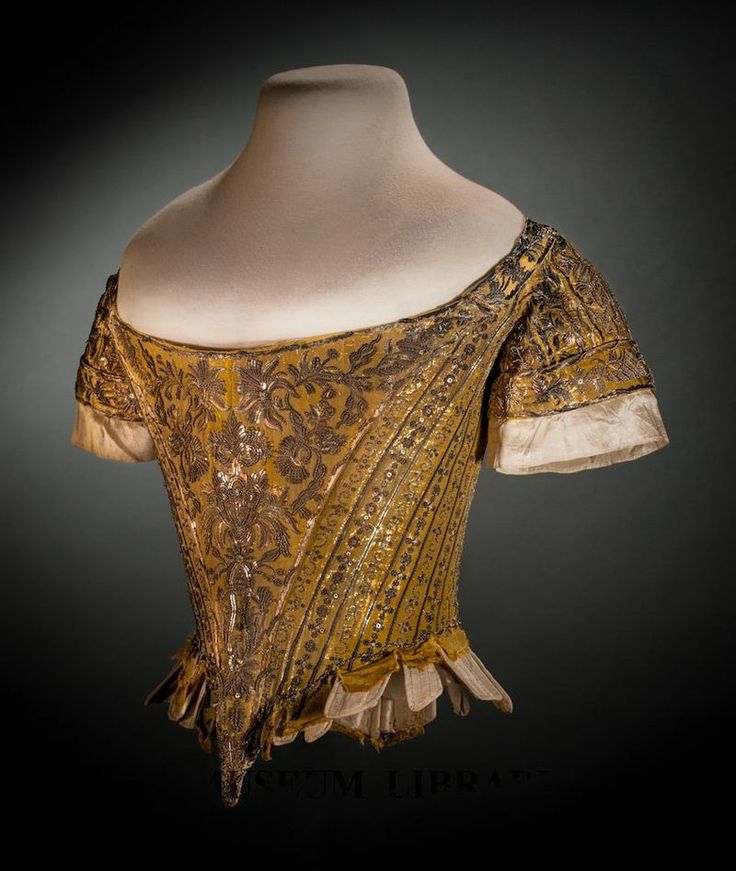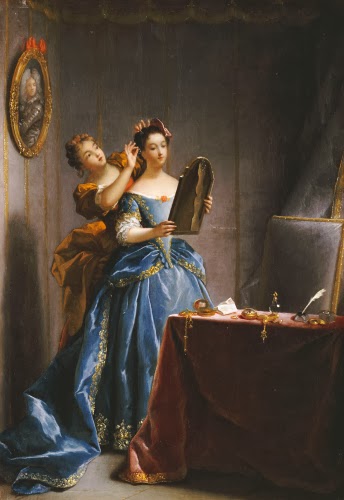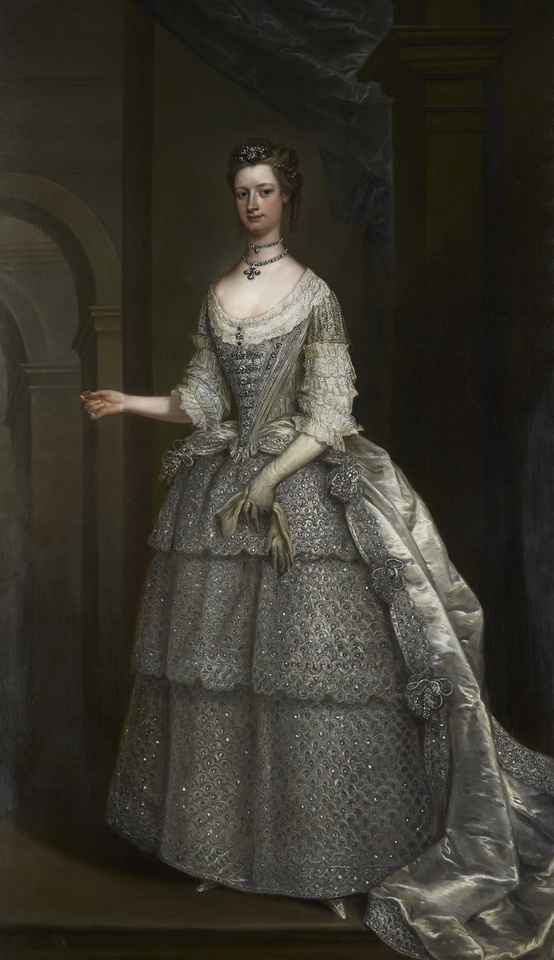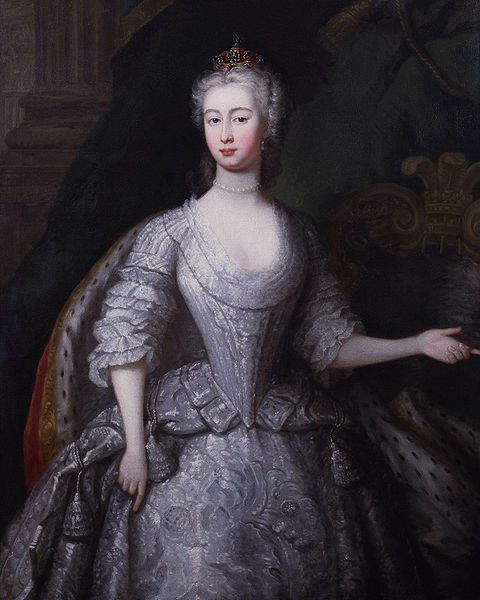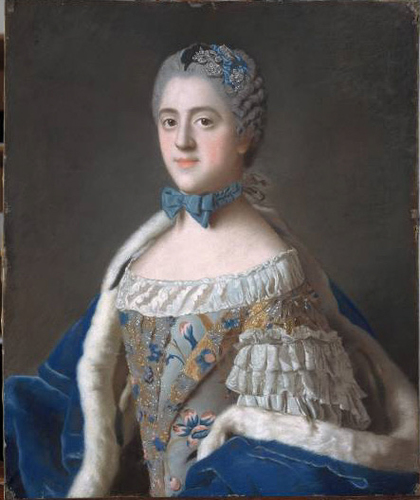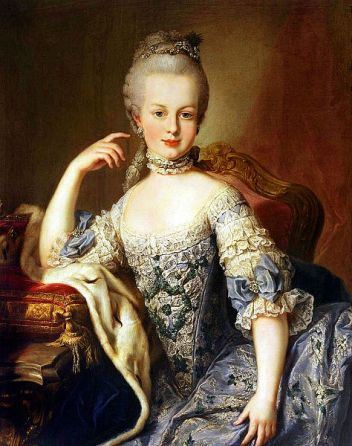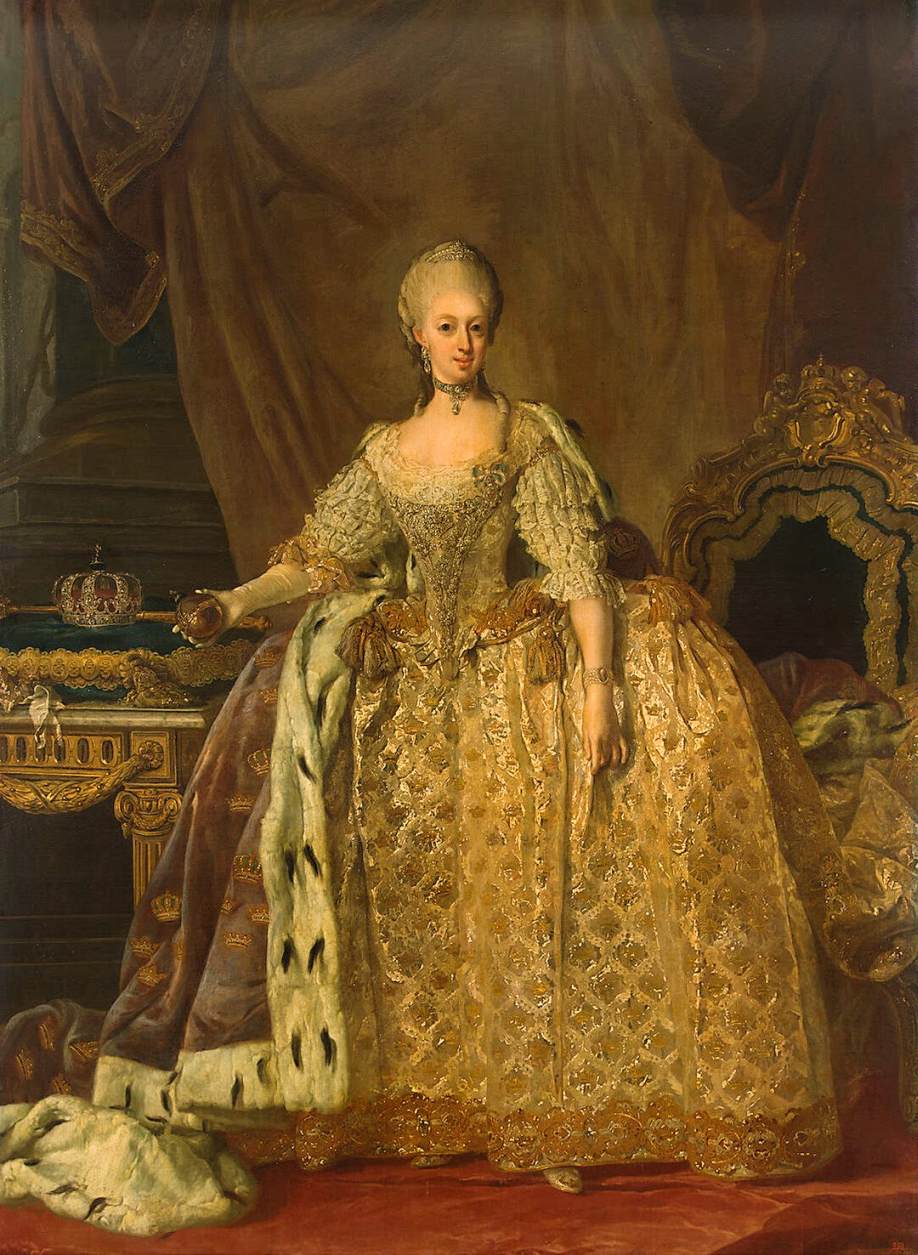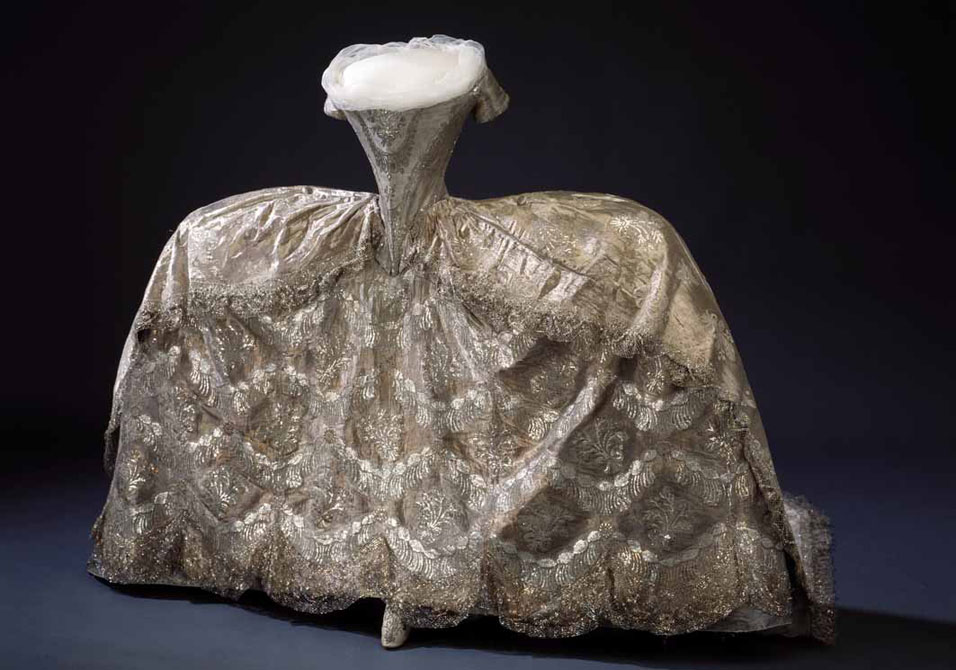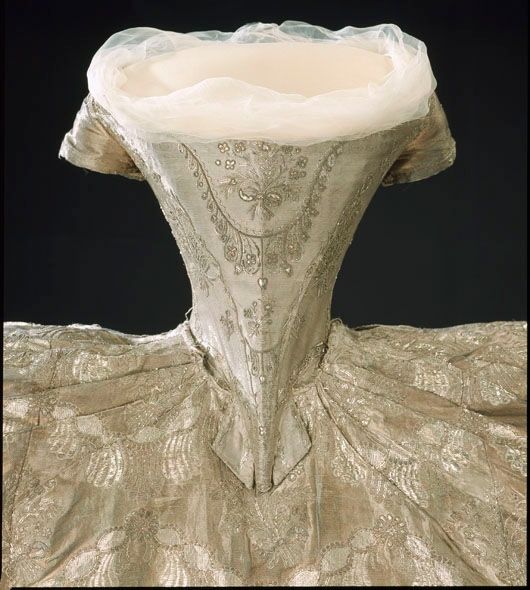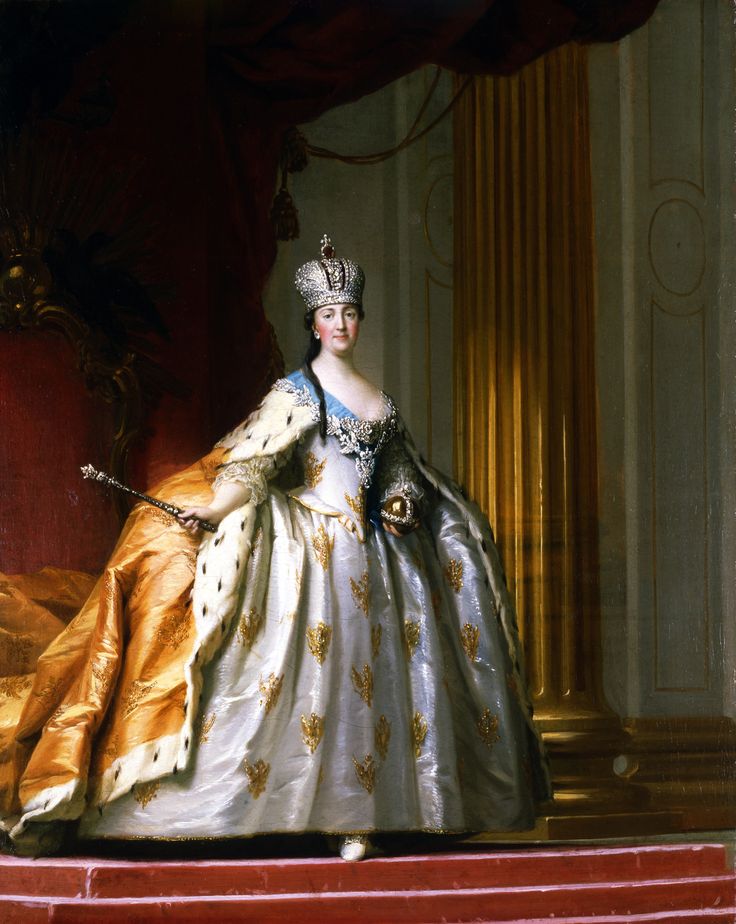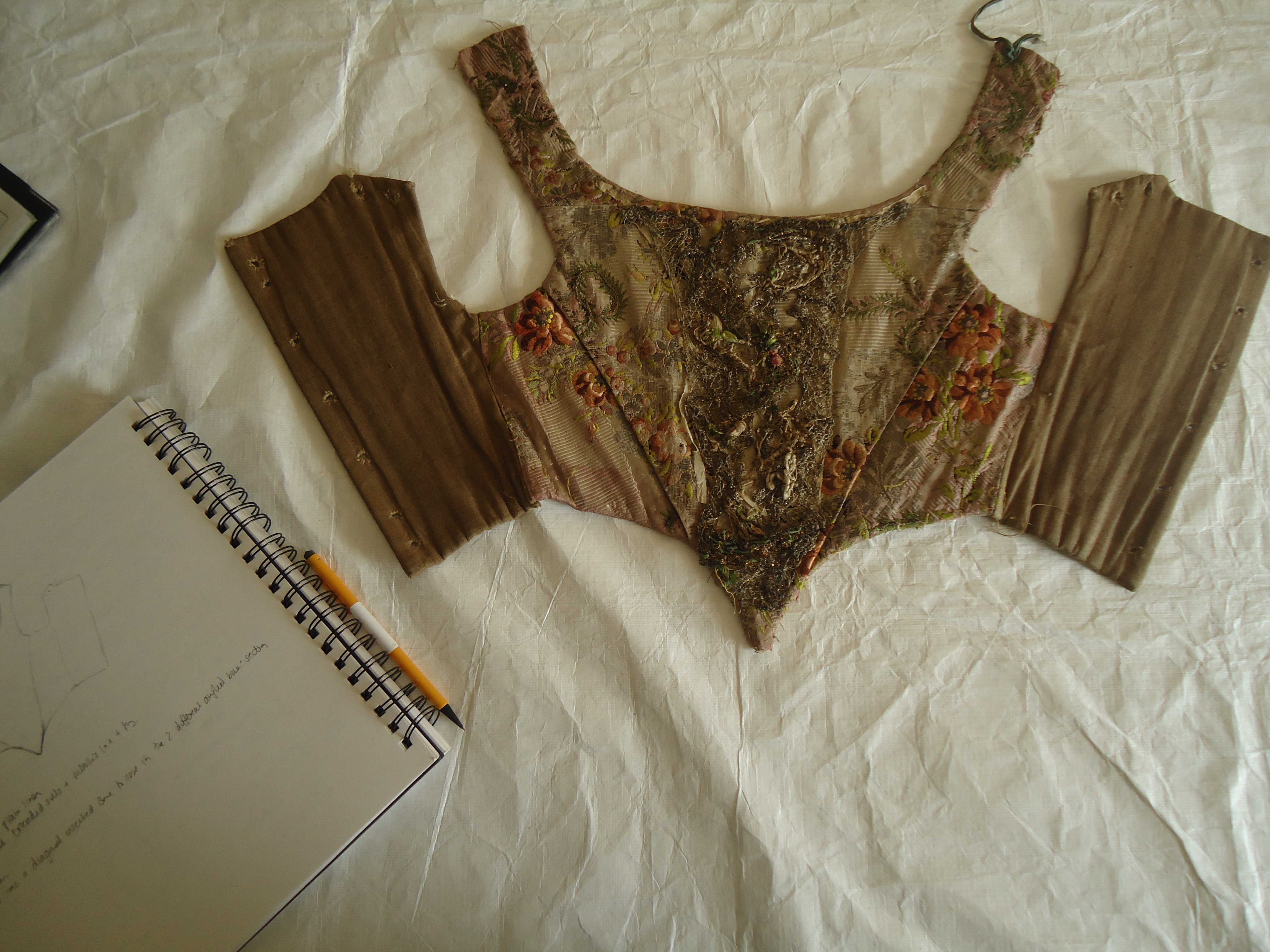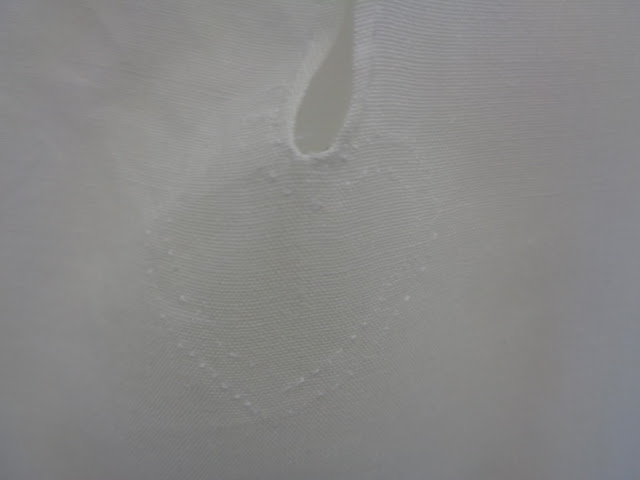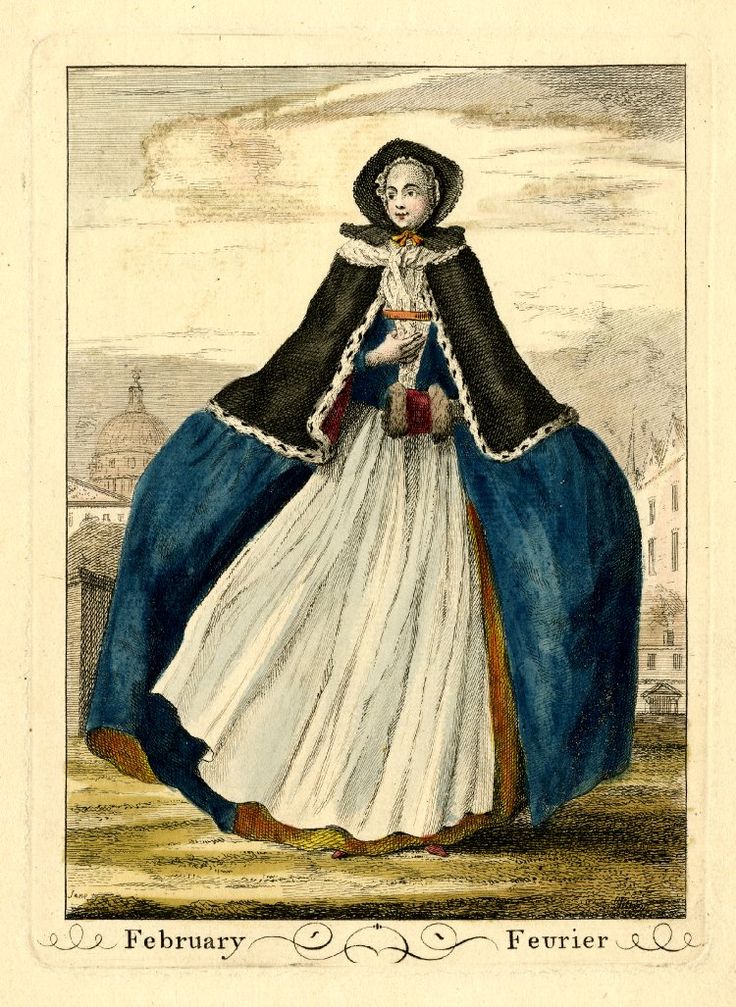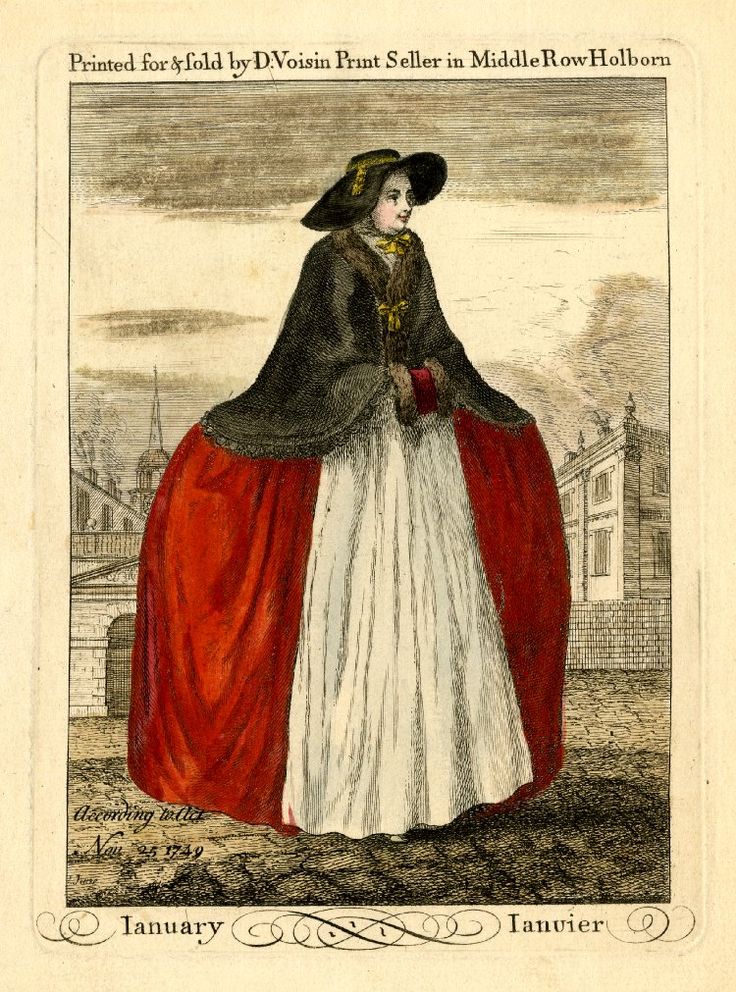The Stiff Bodied Gown:
We like it when we're reading and we come across something the writer is talking about that we have no idea what it is. We did this with coifs when reading our very first historical novel! It's so useful when they show you an image of that item for you to be able to picture it - but better than that is when you can be shown what really marks that garment out, and to be able to see the many versions of it. That garment then is completely cemented in your mind. That's our plan here; do as you'd have others do to you!

- 1761 - Court Bodice
So we have quite a few images of a Stiff Bodied Gown here for your perusal. Spanning over the century, showing it's influx and changes and also, hopefully, being able to give you a bit of background information on it.
Anne Buck describes the Stiff Bodied Gown as: "The Stiff Bodied Gown was a boned bodice worn with a separate petticoat and train." (p.14 in Dress in 18th Century England, A.Buck) which, to be honest pretty much sums it up - atleast, that is, if you only wanted a skeleton understanding of the Stiff Bodied gown - layered on top of that is the variaty of sumptuous fabrics, embroidery and lace, the sleeves, the variations in fashion - all of which made them so splendid. And also - what made them so very different from the other gowns of the period?
To begin with, starting with it's history, this style of Dress was a relic from the previous century - and probably the previous century before that if we look back far enough and follow it's ancestry! It seems to be only seen in the 18th century for big Court Ceremonies such as Coronations and Weddings. Anne Buck's first chapter in her book 'Dress in 18th Century England' deals with Crown and Court so this dress comes up often in that chapter. It had become a ceremonial costume.

- Duchesse de Bourgogne - painted 1705 - no artist details at present.
The Duchess of Bourgogne - 1705:
The painting of the Duchess of Bourgogne is so incredibly entrenched in the 17th century that we've used it to show you the dress' beginnings as it enters the new century - the grand 1700's. The hair is in late 1600's style and so is the shape of her gown. Their silhouette was elongated. What's interesting to us, is that historians like Iris Brooke, suggest that this silhouette in Britain was of Dutch influence and when the 18th Century struck the fashions moved over to a more French Influence. That's all fine and understandable but you can see french ladies in dutch style before the 'New Look' hit. Even this portrait is french. The Duchesse de Bourgogne was very French. Why then is she in Dutch fashion and not French where we supposedly got our next fashions from? It must've been that this silhoette was a fashionable shape across Europe and not just in Britain. After all, the other periods tend to echo similar fashion trends that spanned Europe, so why not so for the end of the 17th century!

- A Lady At Her Toilet - Raoux - 1727
A lady at her Toilet - 1727:
Details:
Well, she's getting ready for a serious night out. It does appear that at the earlier part of the century stiff bodied gowns were a little more common and could also be used for Masquerade nights, as the century progresses so they become more and more formal - very similar in fact to the progression of the Sack Back gown. But here we have our lady in what looks like blue velvet - or atleast a seriously heavy duchess satin with the distinct details of the Stiff Bodied gown - the pulled-to-the-side skirt - the stiff and smooth bodice (looks like a 'torpedo' point to this one!) - the matching petticoat - the wide sweeping neckline. There is one difference with this one and that is the lacking of lace on her sleeves. The sleeve is shorter than a normal gown as with the others, but it doesn't have the rows of facing lace. She also is having her hair dressed simply and elegantly, worn high and the whole thing uncovered.

- Lady Frances Montagu as Court bridesmaid in 1734. No artist details at present.
Lady Frances Montagu - 1734:
We initially wanted to start with this image as it lies fairly early in the century and holds many of the key ingredients to this particular form of costume. We will say here, however, that the tiered skirts is an exception to this rule.
In the above portrait Lady Francis Montagu is dressed in silver (which was a popular colour for weddings and special occasions) in a classic, beyond-classic, version of a Stiff Bodied Gown. Many of these next images have been painted later in the century and blend this Court Gown with the other High fashion of the time - the wide fan Hoop for example, but for here, we have it in a very similar style to the previous century. As you can see, using Buck's quote, it has a Boned bodice - that is a bodice that has the bones in it to create the shape and which has then been covered. In this image there is pretense of a stomacher-shaped centre to the bodice echoing the fashionable shape of the robings and stomacher in undress fashion. The sleeves in this above dress also seem to remain with the Stiff Bodied Gown through out the century - this short, self fabric sleeves with ruffles of gathered Lace sewn down the centre so that they splayed out facing each other. In this particular gown (and in many of the following) the Bodice ends with what we have nicknamed the 'Torpedo Tab', that is to say, the bodice ends with a funny CF point whose main point has got square side tabs attached to it. It then has skirts that are in the Mantua style - i.e. barely making it over the hips and that drape very much to the back and leave a broad space for the Petticoat. In this particular dress the petticoat is unusually layered in 3 tiers and the skirts drape back into a long train.

- Augusta, Princess of Wales painted in 1736 by C.Phillips.
Princess of Wales - 1736:
Details of this dress include a more rounded shaped look to the skirt - possibly a circular hoop rather than an Oval shaped one. According to I.Brooke these two shaped hoops were worn side by side to each other between 1714 and around this date i the 30s where the Circular form dropped out of all visible fashion. Other details include broad tabs and a short CF point - almost creating the 'Torpedo' style but not quite. It also has a kind of triangular shape to the Lower part of the Bodice - this is bizarrely seen throughout the century in stays and is visible right upto the late 90s. The outer skirt begins at the CP and gets swept over to the sides of the hips. The sleeves also have the classic double rows of lace and she wears a flattish frill at the cuff and at the neck of the dress. Also see how deep the neckline goes - below the nipple line surely! The fabric appears silver but with large, bold baroque styled leaves and probably flowers.

- Countess Ancram by E.Seeman - before 1745
The Countess of Ancram by E.Seeman - before 1745:
Details: Hers is in a rich cream satin with a beautiful matching brocade petticoat. Her train and skirts do the usual curtain thing of being swathed back to the sides and has been decorated with, and also what seems common n Stiff Bodied Gowns, large furnishing like tassles. Her neckline has the same deep curve as our lady Augusta Princess of Wales has in the portrait already seen - though the Countess' is a little more modest. Her bodice comes to a single, smooth point and edged with some sort of braid which also decorates the sleeves, and those sleeves are also the classic sleeves we've been seeing.
We'll tell you what's also interesting, all of the ladies painted here wear their hair simple, high and uncovered. Very similar to how we'd do our hair up if we were going to a seriously dressed-up occasion, don't you think?

- Mdm Sophie of France-1750-51-Liotard
Mdm Sophie of France-1750-51-Liotard:
Details: Well to start with, the first thing we've noticed is yet again, this gown is being worn with a large bow at the neck. Is this a possible mid century fashion joining in with the classic formal ceremonial gown? Apart from that most of the rest of it just echoe what we've been seeing. Hers too has the wide, sweeping neckline, the proper short type sleeves (not capped like another version) paired up with the lace section to the sleeves. Her bodice also looks like it has a kind of 'robing' style bit added onto it, that sits ever-so-slightly away from the smoothness of the bodice. It's also in a beautiful grey silk with blue and pink flowers. No lace or metallic trim either which is interesting. The Cunnington's did say that there was a period before the end of the 50s where trimming had kind of faded from gowns. Perhaps this is the reason here....

- Mdam Adelaide of France - 1756 by Nattier
Mdm Adelaide of France - 1756:
The above portrait was painted by Nattier in 1756 of Madame Adelaide de France. It's a stunning portrait and a beautiful colour of silk. Here you can see the same sleeves in this High Court Fashion dress as the one painted 20 years earlier of Lady Montagu. Nattier has painted it exquisitely - look at the front Centre point of the Boned Bodice - you can almost imagine getting your fingers underneath it and being able to see how solid and rigid it was and how very different from the unboned fabric draping around it. This bodice (called the Stays part of the gown in the 18th c) has no tabs unless they are tucked under the petticoat.
Curiously, although it's not really to do with Stiff Bodied Gowns, she is wearing some sort of Self Shawl or outer robe that's been draped over her shoulder. We've never seen this before. You can see what looks like Robings with Furbellow trim hanging down over her Right shoulder (our right) and it looks broader on the other side. This might be an illusion and it might simply be a long length of twisted Necklace which was often made up of a furbelow and lace gathered together and twisted round the neck and down the front of the dress. But it looks like the outer robe having not been pinned down over the 'Stomacher' part of the stays. There was a fashion for being painted with the robings open but it no longer looks like the over robe when you look at her shoulders. Here that lined piece of gathered decoration suddenly looks again like a necklace. Perhaps it was pushed to the side to display the CF. She wears similar tied in a bow round her neck.
Self, by the way, is a technical term that means 'made out of the same fabric as the item'. Furbelows were often 'self', i.e. made of the same fabric as the dress.
M.Antoinette-1767-8 - Meytens

- M.Antoinette-1767-8 - Meytens
Details: Here the famous, and much younger Marie Antionette sits poised in a stiff bodied gown of blue sik with decorative furbelow looking trim on the stomacher part of the bodice. Hers too features the wide and deep curved neckline and has the character lace facing draped along this neckline's edge. Her short sleeves are finished with a mass of lacing ending in a frill that carries a Sleeve Knot on it, also in blue. Her bodice seems to have no tabs and also no skirts - just a matching petticoat -although it is hard to tell with the way the skirts sits poufed up. She also wears a frill at her neck of lace and has her hair powdered but high and with bits dangling - very elegant.

- Maria Elisabeth of Austria-no date
Marie Elisabeth of Austria - Undated:
Details:
We don't really know when this was painted as the portrait goes undated, but with a little research we now know that Marie Elisabeth was born in 1743 and died 1808. We can therefore guestimate that this portrait was painted somewhere between the years of 1760 - 1780. The gown is very simple - this version has no top layer of skirt draped over the wide hips, instead the bodice sits over a plain and wide petticoat which is worn over a very wide pair of hoops. The neckline is both wide and deep and keeps to the formality of smooth curve. The bodice CF point doesn't come down too far and is fairly short - this would make us think it's perhaps a little nearer to the later part of the century - perhaps the 70s-80s. Her sleeves are virtual straps and she wears the full and flouncy lace sleeves also. She has a strange flap of what looks like very fine lace draped over hes shoulders and which fall to her waist. The pattern of her brocaded silk is fairly simple in comparison to some and apart from the sleeves and the floaty thing, she wears no other lace and doesn't seem to have any trims decorating the dress. This could point it to being before the 50s when less trimmed dresses were more popular - but then she would've been 7 so perhaps not!
We also have another painting of this Emperor's daughter in a stiff bodied gown. The following portrait is again of Miss Marie Elisabeth of Austria and with a more certain date of c,1760s...

- Meytens - c.1760 - M.E of Austria
Details: It's a pretty gaudy dress but contains all the features - the long, smooth bodice, the wide and deep curved neckline, the short sleeves with lace ruffles and, in this case, the matching petticoat draped over a wide pair of hoops. She also wears Sleeve knot's as they were called - see the bows at the forearms. She has a green bow tied at her neck as well.

- Queen Sofia's Coronation Gown - 1772
Queen Sofia - 1772:
With this classic gown above, again the outer skirt sits ever so gently on the Petticoat's hips and flowing generously behind into a long, square train. Here you can see the Wide Hooped Oblong Petticoat Fashion remaining in Court wear when it had gone out of every day wear. You can also see the flatter line of the skirts. It was in this quarter of the century when the Sacks became much more slim line and flatter at the front than previous which could be attributing for this style in this dress. But it was not exclusive to this quarter of the century. Wide, wide Hipped Panniers also tended to have a much more fitted petticoat than the smaller ones.
The triangular shape to the Bodice is also clearly seen here again - thick broad busks could be worn -but what's visible in the sister garment, the stays, is that they get made with this triangular point in them. In some of the stays we've studied the lining has been used to hold that triangle - but not in all of them.
Just for note of interest, 3 of the Stiff Bodied gowns shown here have this triangular stomach compared to the 8 out of 11 that don't.

- Queen Sofie Magdalene by Lorentz Pasch - 1773-75
Queen Sofia Magdalene - 1773-75
This painting is of the previous coronation gown. Though in the dressing of the gown where it is actually being worn, there have bee added trims and accessories - like the silver lace. She was coronated in 1772. What is interesting to us is that the triangular concave shape to the bodice hasn't really been captured in the painting - it's nice to know there's a clear example of that!
A reader has supplied us with some links, so we thought we'd put them here:
Coronation gown (1772):
http://emuseumplus.lsh.se/eMuseumPlus?service=ExternalInterface&module=collection&objectId=67861
Queen Sofia Magdalene here was painted a whole 40 years after the portrait of Lady Frances Montagu (2nd painting) and yet you can see the dresses are so similar. Although the skirts are different, the lay out to the Bodice, the sleeves etc are all the same. Much has changed in the day wear from this period to the previous and yet not much of that change reflects in these gowns. The point? - It shows how set apart these gowns were from the fashions of the day and how they were worn specifically for the High Court Occasions.
Wedding Dress worn by Hedwig Holstein-Gottorp -1 774:
The next dress is the famous gown worn by Hedwig Elisabeth Charlotte Holstein-Gottorp at he wedding to King-to-be of Sweden, dated 1774. It's a beauty of a dress and has a character of sleeve that has become to be more fashionable at this stage of the century. We believe Marie Antionette had a similar sleeved gown as well.

- The Hedwig Dress - 1774
Details: well to start with, in this lower picture you can see how the museum has dressed the petticoat over the tabs of the stay part of the gown. You can also see a close detail of a mutation of our beloved 'Torpedo style tab arrangement. You can also see the way the bodice has been manipulated to curve at the lower CF. Isn't it a stunner though!
With the higher image you can see the swept back shoulders (helped created by the style of stays for this period) and the small, plain sleeves. Very in keeping with a regency look aren't they! The bodice then sits smoothly over the petticoat while the typical swept back skirts crown the hips in the form of a drape. Interestingly these skirts seem to sit on top of the bodice.

- Catherine the Great - Erichsen - 1778-79
Catherine the Great - Vigilus Erichsen - 1778-79:
Details: The dress here is a nicely simple version - the ivory and gold brocade making it light on the eye, whilst the gown remains free from trim and lace. The tabs to the bodice seem to just be edged with a matching yellow gold which makes it stand out. You can just about make out the lace ruffles beneath her royal cloak.

- SNO.1294
This photo here was taken from one of a Study Session we had at Berrington Hall. We have no idea if this was part of a stiff bodied gown or if they were a pair of covered stays (not always a lot of difference - especially in 18th c terminology as stays could be used to describe both garments lol). You can see more of this pair of what has been called 'Covered Stays' by the museum, in our Individual Garments Page - Click this link here:
SNO.1294. The reason why we've included it on this page is so you can see the idea behind how the Bodice of a Stiff Bodied Gown would've worked. As a pair of Stays only on the CF section has been decorated and therefore presumably designed to be seen. (Please see our posts on
The Stomacher Style Stays for a deeper look into this black hole of an issue!). It is however, a very similar shape to the Stiff Bodied Gown images. Gosh, this is sounding so confusing!
Is one bored of Stiff Bodied Gowns yet? We could also show their predecessors in the 1600s and show how similar they were to the ones 100 years before, but perhaps that's enough for now. We certainly are aware that this page is beginning to creek at the seams and has become sluggish in it's writing. Oh well. Let's end that here and we can all but hope that when someone says 'Stiff Bodied Gowns' to you now you'll be able to instantly picture what they are talking about.
Thanks for looking and we'd love to hear from you if you've enjoyed this page :)











